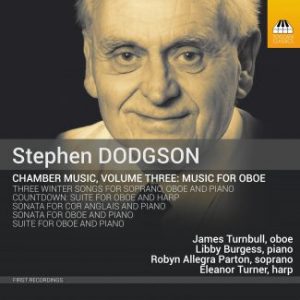 Stephen DODGSON (1924-2013)
Stephen DODGSON (1924-2013)
Chamber Music Volume 3: Music for Oboe
Sonata for Oboe and Piano (1987) [15:01]
Countdown: Suite for Oboe and Harp (1990) [13:49]
Sonata for Cor Anglais and Piano (1967) [14:45]
Three Winter Songs for Soprano with Oboe and Piano (1972) [15:27]
Suite in C minor for Oboe and Piano (1957) [14:41]
James Turnbull (oboe)
Libby Burgess (piano)
Eleanor Turner (harp)
Robyn Allegra Parton (soprano)
rec. 2017, St John the Evangelist Church, Iffley Road, Oxford, UK
TOCCATA CLASSICS TOCC0444 [73:43]
This CD is the third in the Toccata Classics survey of the chamber music of London-born Stephen Dodgson (review of Volume 2). It is a very welcome addition to what one hopes will be a reassessment of his works some years after his death. Dodgson was a familiar voice on Radio 3, particularly on Record Review. He composed a substantial number of works, a huge quantity of them for guitar, but works such as those on this CD show his acute ability to highlight the best aspects of whatever instruments he chose to write for. The first work, the Sonata for Oboe and Piano (1987) shows this ability in spades. There is an elegance so appealing that it has you wanting to hear it again immediately. The opening Intrada sounds like a cheeky Puck announcing “I’m here for fun”, with punctuating notes before the second movement weaves its flowing presence with great beauty. The third movement Capriccioso is noticeable by its contrasting speeds: the oboe slow and deliberate against the piano’s faster moving texture. The serious nature of the fourth movement marked Grave is in stark contrast to the brightly cheerful nature of the fifth Moto perpetuo which shows the oboe in all its engaging facility to dance. As Lewis Foreman in his highly useful notes says, the opening of the final movement Aria e Ciacona demands the use of the word “plangent” to describe it, while the closing section is more flowing. This charming fifteen-minute work is a real duo piece, with the piano a true partner.
Showing that the oboe is a versatile instrument that can be teamed with most others, Dodgson’s gorgeous Countdown is a suite for oboe and harp—and what perfect partners they make. The opening Counting candles was the original commission by Burnham Market Concerts to celebrate the Queen Mother’s 90th birthday in 1990. Dodgson added three more sections a month later for the work’s original players Nicholas Daniel and Ieuan Jones. That original piece is so cleverly constructed that the couplet that Dodgson adds at the end of his score reading ‘90 bars the piece do make, and 90 candles on the cake’ describes the work with amusing accuracy. The oboe represents the candles being set, while the harp lights them and at bar 87, where the score is marked ‘blowing the candles out’, the two instruments musically do just that. The Nocturne is tellingly entitled Counting sheep. Its dreamy mood perfectly captures that semi-sleepy state just before dropping off completely. The third section is a Burlesque(Counting money) with the harp sounding for all the world like coins being sorted and stacked, and the oboe the counter sounding pleased at the mounting pile. The closing Envoi, subtitled Counting your blessings, is in a deliciously gentle and lyrically dancing mood. The harp is doing what it does best: provide an innocent-sounding canvas upon which the oboe weaves its magical contribution.
 Stephen Dodgson’s Sonata for Cor Anglais and Piano is another beautifully written work for an instrument with a slightly softer and rather more rounded sound than the more penetrating one the oboe presents, due to its pitch a fifth lower than the oboe. Indeed it is the quality of sound that the oboe produces that has established its position as the instrument required to give the orchestra its tuning pitch. Dodgson’s works for many different instruments, often written with specific players in mind, were often the result of commissions from those musicians, as is the case here. This sonata is a substantial work, almost fifteen minutes long. Its haunting main four-note motif is repeated several times in the opening Andante con moto to great effect. The following Vivace shows the instrument’s ability to be lively when required. The Poco adagio comprises a beautifully and searching lyrical line, while the Allegro non tanto finale contrasts its jaunty opening motif with a more songlike second subject, demonstrating the instrument’s versatility in mood painting.
Stephen Dodgson’s Sonata for Cor Anglais and Piano is another beautifully written work for an instrument with a slightly softer and rather more rounded sound than the more penetrating one the oboe presents, due to its pitch a fifth lower than the oboe. Indeed it is the quality of sound that the oboe produces that has established its position as the instrument required to give the orchestra its tuning pitch. Dodgson’s works for many different instruments, often written with specific players in mind, were often the result of commissions from those musicians, as is the case here. This sonata is a substantial work, almost fifteen minutes long. Its haunting main four-note motif is repeated several times in the opening Andante con moto to great effect. The following Vivace shows the instrument’s ability to be lively when required. The Poco adagio comprises a beautifully and searching lyrical line, while the Allegro non tanto finale contrasts its jaunty opening motif with a more songlike second subject, demonstrating the instrument’s versatility in mood painting.
In Three Winter Songs Dodgson shows his facility for vocal works. He takes three poems by George Crabbe, Osbert Sitwell and Hilaire Belloc (best known and loved for his Cautionary Tales and Bad Child’s Book of Beasts), and creates the most atmospheric set of songs describing winter chill. The oboe is the ideal choice to conjure the sparseness of the season against the soaring soprano, anchored by the accompanying piano. With minimum trimming of the text, Dodgson shapes the music around the words to great effect.
The final work in this showcase of Dodgson’s works for oboe, his Suite in C minor for Oboe and Piano is the earliest, dating from 1957. In this series of five short movements one can see that Dodgson already had a keen understanding of the oboe’s strengths which he knew how to fully exploit. Because of the beauty of the oboe’s sound it follows that almost anything written for it will have that sumptuous and vibrant element that makes oboe works so attractive to the ear. This piece is no exception. Bucolic, bluesy, reflective, dreamy and dancing natures are all evident in this infectious fourteen-minute work.
Hats off to all four musicians on this disc: James Turnbull for his quite luminescent playing on both oboe and cor anglais, Libby Burgess for her faithful and sympathetic pianism, Eleanor Turner for a meltingly gorgeous harp in Countdown, and Robyn Allegra Parton for a superb rendition of the Three Winter Songswhich, together with Turnbull’s engaging playing made for a highlight on this already highly enjoyable disc.
Steve Arloff
MusicWeb International
http://www.musicweb-international.com/classrev/2018/Apr/Dodgson_chamber_v3_TOCC0444.htm





